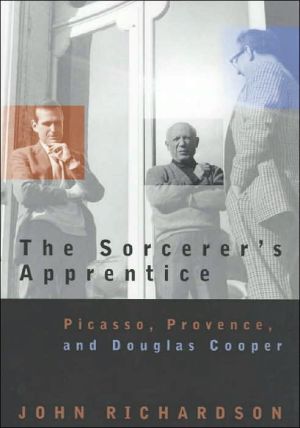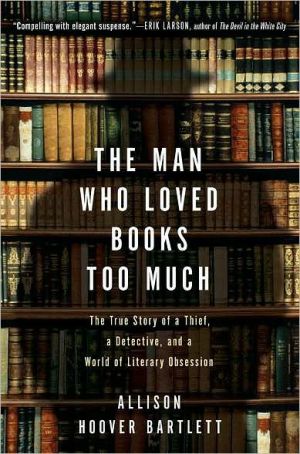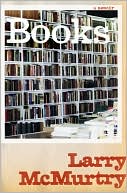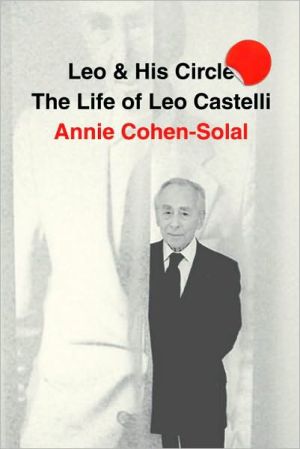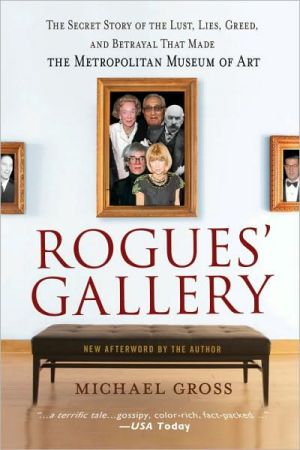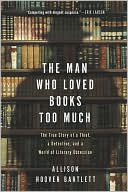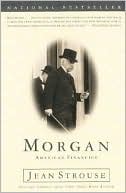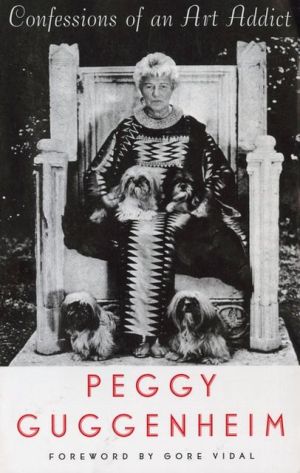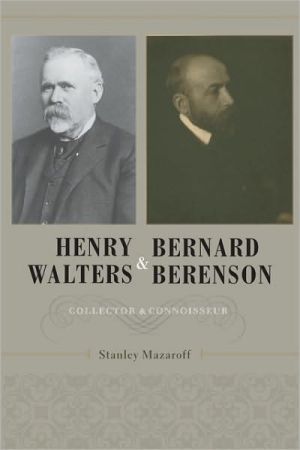The Sorcerer's Apprentice: Picasso, Provence, and Douglas Cooper
The Sorcerer's Apprentice is John Richardson's vivid memoir of the time he spent living with and learning from the deeply knowledgeable and temperamental art collector, Douglas Cooper. For ten years the two entertained a circle of friends that included Jean Cocteau, W. H. Auden, Tennessee Williams, and, most intriguingly, Pablo Picasso. Compulsively readable and beautifully illustrated, this book is both a triple portrait of the author, Cooper, and Picasso, and a revealing look at a crucial...
Search in google:
The Sorcerer's Apprentice is John Richardson's vivid memoir of the time he spent living with and learning from the omniscient but irascible art collector, Douglas Cooper. For ten years the two entertained a circle of friends that included Jean Cocteau, Isiah Berlin, Fernand Leger and, most intriguingly, Pablo Picasso. Compulsively readable and illustrated throughout, this book is a triple portrait of the author, Cooper, and Picasso, as well as a revealing look at a crucial artistic period.Publishers WeeklyRichardson is the acclaimed biographer of Picasso, so his gossipy, candid memoir of his 12-year affair with cubist art collector Douglas Cooper (1911-1984) and their doings as part of Picasso's inner circle is something of an art-world event. Painter-turned-critic Richardson first became involved with flamboyant art historian Cooper in 1949, when he was 25 and Cooper 38. Together they moved into and restored a dilapidated 16th-century chateau in Provence, filling it with pictures by Klee, L ger, Mir and Picasso. In Richardson's withering, occasionally bitter portrayal, Cooper--the mentor who opened up the world of modern art to him--is presented as abusive, vainglorious, vindictive, viciously competitive, a Jekyll/Hyde whose bright, sweet exterior masked a cauldron of envy, resentment and rage. Though Richardson describes their stormy relationship as one held together by a passionately shared experience of works of art, one wonders why they stayed together so long if Cooper was truly so horrible. Through Richardson's eyes, we see Picasso as a protean genius turning out paintings, prints, sculpture and ceramics on a grand scale, but also as an egocentric, misogynistic sadist. One spurned mistress, Dora Maar, sobs over Picasso's brutally anatomic, erotic drawings of her, while another mistress (later his wife), Jacqueline Roque, is pathetically subservient and self-sacrificial, turning to drink for consolation. Splendidly illustrated with 121 photographs and art reproductions, this vivid reminiscence shines with its firsthand glimpses of painters Francis Bacon, Georges Braque, Graham Sutherland, poets W.H. Auden and James Schuyler, art historian/spy Anthony Blunt, Bernard Berenson, Jean Cocteau, Isaiah Berlin and many more. First serial to Vanity Fair. (Dec.) Copyright 1999 Cahners Business Information.
To cheer myself up, I would sneak off with friends my own age. Sometimes we would cruise the Soho pubs, especially the Golden Lion, or the French Pub, where we would watch Francis Bacon on the prowl. Sometimes we would go to the Gargoyle Club, whose mirrored dance floor had seen up the knickers of most of the girls I knew, not to mention their mothers', but it was too full of raffish upper-class drunks for my taste. In quest of hotter music, we would go to the darker, loucher Caribbean Club, where we would find more stimulating company -- Lucian Freud or Michael Wishart or some wild girls we had known at the Slade -- and boogie the night away. I picked up my first and last whore at the Caribbean. Carmencita, she was called. As I hoped to be a father, I thought this experience would straighten me out. No such luck. Carmencita had a terrible cold and, instead of being exhilaratingly whorish, was depressingly genteel. After it was all over, she told me there was "a little pink taowel at the bottom of the bed."\ \ And then one fateful day, in the spring of 1949, Cuthbert said he was taking me to a party given by John Lehmann, the editor of a little magazine called New Writing, in honor of the publication of Paul Bowles's painfully good book, The Sheltering Sky. I was delighted. American writers had a way of heading straight for Paris and missing out on London. Scenting free drink, Grub Street arrived en masse, and the wine ran out even faster than usual. Lehmann was famously parsimonious, and used postwar shortages as a cover for his economies. Unless they had brought hip flasks, thirsty guests had to fall back on assorted bottles of invalid port, cooking sherry, or a nausea-inducing"cup." Bowles had arrived from Tangier with a supply of hashish fudge, something few of us had tried.\ \ As the mixture of drinks, not to mention the fudge, began to take effect, I realized I was being stalked by a stout pink man in a loud checked suit. At first I did not recognize him out of uniform. "You may not remember me," he said in his aggressively accented voice. "We met at the house of that Poufmutter, Mrs. King. My name is Douglas Cooper." This time I was too full of curiosity to flee. I blurted out that I wanted to see his pictures. "Right now, my dear, if you can tear yourself away from these hideous mediocrities," he replied. Despite (or maybe because of) Francis's warnings, I agreed to do so. Then, remembering that Cuthbert expected me to dine with him, I hurried over to ask him whether he minded. "Of course I don't," he said. As if to confirm that this was not true, he allowed a tear to trickle slowly out from under his glasses. People noticed, nudged each other, and pointed. "Poor old Cuthbert," somebody said as I left the room. Parked outside was Douglas's car (at least he said it was his): an ancient Rolls-Royce two-seater with a jump seat at the back. It was painted bright yellow and black like a wasp -- a villain's car if ever I saw one. I climbed up into it, and after some tallyho blasts on an antiquated horn, we sped away -- and then abruptly stopped, a mere two or three hundred yards away. Home, Douglas announced, disconcertingly. That this would soon be my home never occurred to me.
AcknowledgmentsArmy and Navy Child3Douglas Cooper19First Night43Grand Tour55Back on the Road71The Revelation of Castille87Miscreants, Pets, and Neighbors105A Trip with Picasso125The Visitors' Book139Graham Sutherland and the Tate Affair157God Save the Queen171Painters and Paintings181Picasso and Dora203Collectors223Picasso and Jacqueline233The Sorcerer's Apprentice251The Beginning of the End263The End281Epilogue297Select Bibliography305Index307
\ Publishers Weekly - Publisher's Weekly\ Richardson is the acclaimed biographer of Picasso, so his gossipy, candid memoir of his 12-year affair with cubist art collector Douglas Cooper (1911-1984) and their doings as part of Picasso's inner circle is something of an art-world event. Painter-turned-critic Richardson first became involved with flamboyant art historian Cooper in 1949, when he was 25 and Cooper 38. Together they moved into and restored a dilapidated 16th-century chateau in Provence, filling it with pictures by Klee, L ger, Mir and Picasso. In Richardson's withering, occasionally bitter portrayal, Cooper--the mentor who opened up the world of modern art to him--is presented as abusive, vainglorious, vindictive, viciously competitive, a Jekyll/Hyde whose bright, sweet exterior masked a cauldron of envy, resentment and rage. Though Richardson describes their stormy relationship as one held together by a passionately shared experience of works of art, one wonders why they stayed together so long if Cooper was truly so horrible. Through Richardson's eyes, we see Picasso as a protean genius turning out paintings, prints, sculpture and ceramics on a grand scale, but also as an egocentric, misogynistic sadist. One spurned mistress, Dora Maar, sobs over Picasso's brutally anatomic, erotic drawings of her, while another mistress (later his wife), Jacqueline Roque, is pathetically subservient and self-sacrificial, turning to drink for consolation. Splendidly illustrated with 121 photographs and art reproductions, this vivid reminiscence shines with its firsthand glimpses of painters Francis Bacon, Georges Braque, Graham Sutherland, poets W.H. Auden and James Schuyler, art historian/spy Anthony Blunt, Bernard Berenson, Jean Cocteau, Isaiah Berlin and many more. First serial to Vanity Fair. (Dec.) Copyright 1999 Cahners Business Information.\ \ \ \ \ Library JournalIn this remarkably candid memoir, the author of the ongoing, acclaimed A Life of Picasso recounts his own life with Douglas Cooper, his mentor in post-World War II France. Richardson was a young man when he met Cooper and became his confidante. Cooper renovated a villa in Castille, which became a social hub; his collection of cubist art was the best private collection in the world, and his opinions were widely sought after. Moreover, Cooper's exotic behavior earned him a favored place in Picasso's court, and Cooper and Richardson's friendship with the artist yielded many treasured gifts. It also gave the author a behind-the-scenes look at the art world and high society. But there was a dark side to Cooper, related by Richardson rather objectively, considering that when Richardson moved to America Cooper burned all his belongings. Perhaps the keenly observed Sorcerer's Apprentice signals a change in future volumes of A Life of Picasso, reflecting first-hand experiences more than secondary sources. Art watchers will revel in this seamless account, and the many illustrations and photographs add a personal touch to a public dialog. Recommended for general as well as specialized collections. [Previewed in Prepub Alert, LJ 7/99.]--Ellen Bates, New York Copyright 1999 Cahners Business Information.\ \ \ BooknewsRichardson (the award winning author of ), presents a sharply etched portrait of Cooper, the colorful figure who single-handedly assembled the world's most important private cubist collection. It is also the story of Cooper's and Richardson's association, which began in 1949, and came to fruition and ultimate disaster at the 18th-century colonnaded folly in Provence that they restored and filled with artistic masterpieces. Contains 124 b&w photographs and illustrations. Annotation c. Book News, Inc., Portland, OR (booknews.com)\ \ \ \ \ David EbonyThe Sorcerer's Apprentice is eminently readable and illuminating. It manages to explore a highly charged interaction between art and society as it revives a lost time and place.\ —Art In America\ \ \ \ \ Tim HiltonThe Sorcerer's Apprentice is a personal memoir. It is also history written by a raconteur. At the end of the war, we learn, Cooper acted as the interrogator of captured Nazis. "Torquemada could hardly have done better", Richardson murmurs, though he was not himself present at sessions which are said to have astonished Cooper's fellow officers. As The Sorcerer's Apprentice proceeds, one comes to relish the descriptions of Cooper's gargantuan awfulness. Nobody could better describe the bully and braggart than Richardson, who adds personal matter of rare interest... \ ...Richardson is too casual, airy, when he invokes a society to which his readers do not belong. So he writes that Blunt's Soviet controller was "seemingly a Hungarian publisher for all we knew". Here is a superior form of name-dropping. It may be relevant that Richardson had a courtier's role during his years in Provence. He has the manner of someone who had known court secrets. Richardson is glad to report the indiscreet royal stories with which Blunt enlivened Cooper's dinner table, though in fact these tales are not very interesting. A far better story is his account of Picasso's sudden whimsy in deciding the Princess Margaret would make him a suitable bride. In a characteristic ex-courtier way, he allows us to know that "many years later I told Princess Margaret the story of Picasso's quest for her hand. Like her great-great-grandmother Queen Victoria, she was not amused...."\ —The (London) Times Literary Supplement\ \ \
